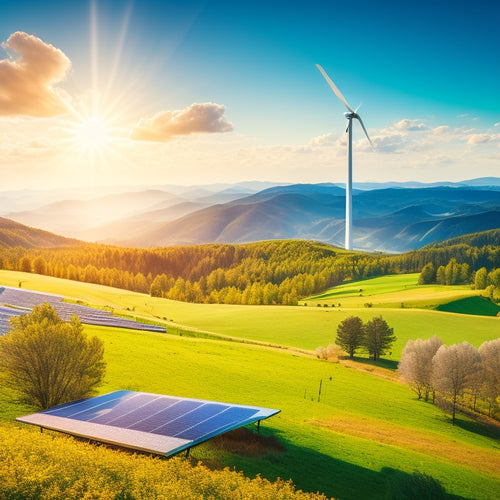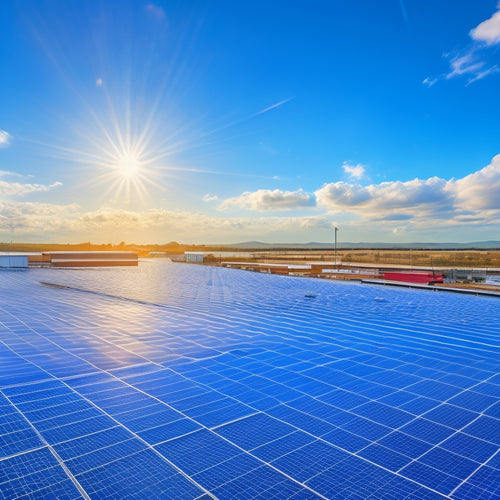
Inspecting Home Energy Systems for Efficiency
Share
You're wasting approximately 30% of your home energy due to inefficiencies, translating to increased utility bills and a larger carbon footprint. To optimize your energy systems, inspect your home's envelope for air leaks, upgrade insulation, and optimize your HVAC settings. Regular maintenance guarantees systems operate efficiently, while energy audits identify areas for improvement. By addressing these inefficiencies, you can save up to $1000 on your energy bills. Now that you've taken the first step towards energy efficiency, you'll want to investigate more strategies to maximize your energy savings and reduce your environmental impact.
At a Glance
- Conduct energy audits to identify inefficiencies and opportunities for improvement in home energy systems.
- Inspect the home's envelope for gaps and cracks, and seal air leaks to reduce energy waste and improve indoor air quality.
- Optimize HVAC settings, including proper humidity control, regular filter maintenance, and programmable schedules, to reduce energy consumption.
- Upgrade to energy-efficient appliances and incorporate renewable energy sources, such as solar power, to reduce reliance on non-renewable energy.
- Implement real-time energy usage tracking to identify high usage areas and optimize energy consumption patterns for improved efficiency.
Reduce Energy Waste Now
You can greatly reduce energy waste by addressing two key areas: sealing air leaks and optimizing your heating, ventilation, and air conditioning (HVAC) settings.
By incorporating a reliable home battery storage solution to store excess energy generated by your solar panels, you can further minimize energy waste and maximize efficiency.
Air leaks, which can be found in walls, floors, and ceilings, allow heated or cooled air to escape, wasting energy and increasing your utility bills.
Seal Air Leaks Now
Air leaks in your home's envelope - the outer walls, windows, doors, and roof - allow heated or cooled air to escape, causing your heating and cooling systems to work harder to maintain a comfortable temperature. This not only increases your energy bills but also compromises indoor air quality.
By integrating a battery storage system into your solar setup, you can store excess energy generated by your panels during the day to use at night or during power outages, reducing your reliance on the grid and energy waste. Sealing air leaks is an essential step in reducing energy waste and creating a more comfortable living space.
Start by inspecting your home's envelope for gaps and cracks. Check for openings around windows, doors, electrical outlets, and switches. Use caulk or weatherstripping to seal any gaps you find.
Don't forget to inspect your attic, basement, or crawl space for air leaks, as these areas can be significant sources of energy loss.
Consider upgrading your insulation to further reduce heat transfer. This can include adding insulation to your attic, walls, or floors. Proper insulation will help maintain a consistent indoor temperature, reducing the load on your heating and cooling systems.
Optimize HVAC Settings
Tune up your heating, ventilation, and air conditioning (HVAC) system by optimizing its settings to reduce energy waste. You can start by guaranteeing proper humidity control, which helps prevent moisture buildup and reduces the load on your HVAC system.
Regular filter maintenance is also essential, as dirty filters can increase energy consumption and decrease airflow. Consider upgrading to a high-efficiency filter or installing a whole-house dehumidifier for improved performance.
By integrating Home Solar Battery storage solutions, you can further reduce your reliance on non-renewable energy sources and shield yourself from fluctuating grid prices. Additionally, optimizing your HVAC settings can help you get the most out of your solar power storage system.
Programmable schedules allow you to automate temperature adjustments, so you can save energy when you're not home or when you're sleeping. Airflow optimization can be achieved through duct cleaning and sealing, which helps your HVAC system operate more efficiently.
If you have a multi-story home, consider installing zoning systems to direct heated or cooled air only to occupied areas. Regular maintenance checks can identify potential issues before they become major problems, and guarantee system compatibility with other energy-recovery systems.
Saves Up to $1000
By optimizing your home energy systems, you'll lower your bills and reduce energy waste.
With the rise of affordable solar solutions, homeowners can now consider residential solar panels as a viable option to reduce their electricity costs. This can lead to significant cost savings, up to $1000 per year.
Lower Your Bills
Saving hundreds of dollars on your energy bills is a tangible reality when you optimize your home energy systems. By implementing a few key strategies, you can greatly reduce your energy consumption and lower your bills.
One effective approach is to conduct an energy audit, which involves a thorough examination of your home's energy usage to identify areas of inefficiency. This audit will pinpoint opportunities to improve insulation, seal air leaks, and upgrade to energy-efficient appliances. You may be eligible for utility incentives, such as rebates or discounts, for making these energy-saving upgrades.
Additionally, consider installing a smart thermostat to optimize your heating and cooling systems. By taking these steps, you can save up to $1000 on your energy bills annually.
With the money you save, you'll have more freedom to invest in the things that matter most to you. By optimizing your home energy systems, you'll not only reduce your energy consumption but also increase your financial independence.
Cut Energy Waste
Around 30% of the energy consumed in your home is wasted due to inefficiencies, resulting in unnecessary expenses on your energy bills. Cutting energy waste is essential to reducing your energy consumption and saving up to $1000.
You can start by conducting an energy audit to identify areas of inefficiency. Improving insulation, installing energy-efficient appliances, and utilizing renewable resources are effective ways to reduce energy waste.
Behavioral changes, such as turning off lights and electronics when not in use, can also make a significant impact. Utility incentives and rebates can help offset the cost of these upgrades.
Consider the building orientation and ventilation strategies to optimize natural light and heat. Lighting upgrades, such as switching to LEDs, can also reduce energy consumption.
Regular maintenance schedules can help guarantee your systems are running efficiently. By implementing these strategies, you'll be well on your way to cutting energy waste and enjoying the financial freedom that comes with it.
Smart Thermostat Integration
When you integrate a smart thermostat into your home energy system, you'll reveal significant energy savings potential by optimizing temperature settings and reducing heating and cooling waste.
This advanced system control enables you to fine-tune your energy usage, making it easier to identify areas of inefficiency and implement changes that add up to big savings.
By incorporating Renewable Energy Systems and leveraging Residential Energy Storage solutions, you can further reduce your reliance on the grid and lower your electricity bills.
Energy Savings Potential
Your home's heating and cooling system is a significant contributor to your energy consumption, accounting for nearly half of your total energy bill. By integrating smart thermostats into your energy management system, you can access significant energy savings potential.
Conducting an energy audit can help identify areas of inefficiency and opportunities for improvement. Upgrading to energy-efficient appliances, insulation improvements, and home retrofits can also yield substantial energy savings.
Moreover, incorporating renewable sources into your energy mix can further reduce your reliance on non-renewable energy sources. Behavioral changes, such as adjusting your thermostat settings or using smart technology to optimize energy usage, can also contribute to energy efficiency.
A cost-benefit analysis can help you determine which energy-saving measures will provide the greatest return on investment. By implementing these strategies, you can take control of your energy consumption, reduce your energy bills, and enjoy the freedom that comes with energy independence.
With smart thermostat integration, you can optimize your energy management and access the full potential of your home's energy system.
Seamless System Control
By optimizing your home's energy management system with smart thermostats, you can access seamless system control, allowing for real-time monitoring and adjustments to your energy usage.
This integration enables you to centralize control of your home's energy systems, ensuring that every component works in harmony to minimize energy waste and maximize efficiency.
With smart thermostats, you can enjoy a seamless user experience, effortlessly switching between energy-saving modes and adjusting temperature settings from a single interface.
System interoperability is key, as it allows your smart thermostat to communicate with other energy management systems, such as lighting and HVAC controls, to create a unified energy-saving strategy.
Consider Your Climate Zone
You should consider your climate zone when designing a home energy system, as regional weather patterns and local temperature extremes greatly impact energy efficiency.
For instance, in areas with high temperature fluctuations, incorporating solar powered homes can help reduce reliance on grid electricity and lower your carbon footprint.
In areas with high temperature fluctuations, your system must be able to handle both heating and cooling demands.
Regional Weather Patterns
How drastically do regional weather patterns impact the performance of home energy systems?
It's essential to take into account your climate zone when evaluating your home's energy efficiency. Regional weather patterns greatly influence the performance of your heating, ventilation, and air conditioning (HVAC) system, insulation, windows, and doors.
The climate impact on your home's energy consumption is substantial, and seasonal adjustments are necessary to optimize energy efficiency.
In regions with extreme cold or hot temperatures, your HVAC system works harder to maintain a comfortable indoor temperature. This increases energy consumption, leading to higher utility bills.
In regions with high humidity, your HVAC system must also work to remove excess moisture, further increasing energy consumption.
Understanding regional weather patterns allows you to make informed decisions about your home's energy system. By adjusting your system's settings according to seasonal changes, you can reduce energy waste and lower your utility bills.
For example, in colder climates, you may need to adjust your thermostat to a lower temperature during winter months or install insulation to reduce heat loss.
Local Temperature Extremes
Regional weather patterns greatly impact home energy systems, and understanding local temperature extremes is vital to optimizing energy efficiency.
As you inspect your home energy system, it's essential to take into account the temperature extremes in your climate zone. Extreme weather conditions, such as scorching summers or freezing winters, can greatly affect your energy consumption and thermal comfort.
In hot climates, high temperatures can lead to increased cooling demands, while in cold climates, low temperatures can result in higher heating demands.
Understanding these local temperature extremes helps you identify opportunities to improve your home's energy efficiency. For instance, you may need to invest in insulation, energy-efficient windows, or a high-performance HVAC system to maintain thermal comfort while minimizing energy consumption.
Real-Time Energy Usage Tracking
You can optimize your home's energy efficiency by monitoring energy consumption rates in real-time, allowing you to identify areas of high energy usage and make adjustments accordingly.
Real-time tracking enables you to see how much energy your appliances, lighting, and HVAC systems are using at any given moment, helping you pinpoint opportunities for improvement.
Monitor Energy Consumption Rates
Several key benefits emerge when homeowners can monitor their energy consumption rates in real-time.
You'll gain a deeper understanding of your energy usage patterns, allowing you to identify areas for improvement and optimize your energy efficiency. With real-time energy monitoring, you can track your consumption analysis and pinpoint appliances or systems that are guzzling energy. This information enables you to make informed decisions about your energy usage, giving you the freedom to reduce your energy bills and environmental footprint.
You'll be able to see how different activities, such as cooking or laundry, impact your energy consumption. This granular level of perception enables you to adjust your behavior and make changes that add up to significant savings over time.
Additionally, real-time energy monitoring can help you detect energy-wasting issues, like faulty appliances or inefficient systems, so you can address them promptly. By monitoring your energy consumption rates, you'll be in control of your energy usage, making it easier to achieve your energy efficiency goals.
Frequently Asked Questions
How Often Should I Inspect My Home's Energy Systems for Optimal Efficiency?
You should inspect your home's energy systems seasonally to guarantee peak efficiency, as failing to do so can lead to energy waste and higher bills, ultimately limiting your financial freedom.
Can I Perform Energy System Inspections Myself or Hire a Professional?
Like a skilled chef perfecting a recipe, you're assessing DIY inspections versus professional services. While DIY inspections can save money, they may overlook hidden issues; consider hiring a pro for a thorough, data-driven assessment to optimize your energy system's performance.
What Are the Most Common Energy-Wasting Culprits in a Typical Home?
You'll often find that insulation gaps, outdated appliances, and inefficient lighting fixtures are the most common energy-wasting culprits in your home, quietly draining your wallet and increasing your carbon footprint without you even realizing it.
How Long Does a Typical Home Energy System Inspection Take to Complete?
You'll spend around 2-4 hours on an inspection, depending on your home's size and energy system types, like HVAC, plumbing, and electrical systems, which will give you an extensive view of your energy usage and areas for improvement.
Are Energy System Inspections Covered Under Homeowner's Insurance Policies?
You'll typically find that energy system inspections aren't covered under standard homeowner's insurance policies, but some providers may offer add-ons or riders for routine maintenance, which can help offset the cost of inspecting and maintaining your systems.
Explore More
As you've inspected your home energy system, imagine a once-leaky faucet now tightened, wasting no more precious resources. Your smart thermostat integration is the conductor, orchestrating a harmony of efficiency. With real-time tracking, you're the ruler of your energy domain. By considering your climate zone, you've customized your approach to perfection. The result? Up to $1000 in savings, shining like a lighthouse of environmental stewardship. Your home, once an energy-wasting culprit, is now a model of sustainability, thanks to your diligence.
Related Posts
-

Renewable Energy Solutions to Reduce Your Carbon Footprint
To reduce your carbon footprint, adopting renewable energy solutions is key. Using solar panels or wind turbines can ...
-

Why Outdoor Solar Lighting Systems Are Sustainable
Outdoor solar lighting systems are sustainable because they utilize renewable energy, drastically reducing your carbo...
-

Commercial Solar Energy
As you consider powering your business with commercial solar energy, you'll uncover it offers a triple benefit: signi...


